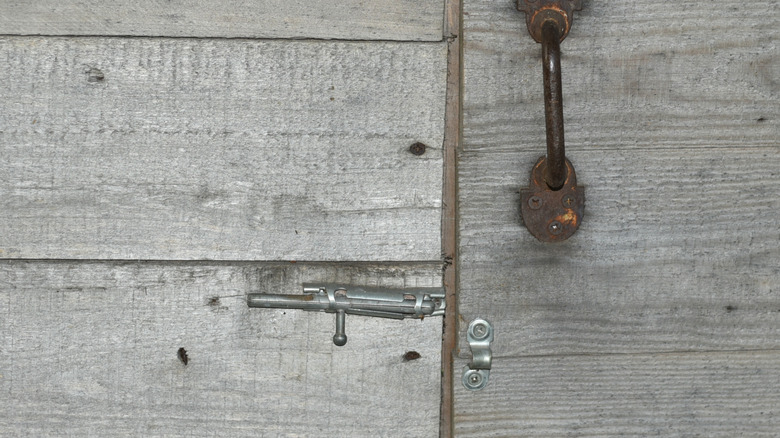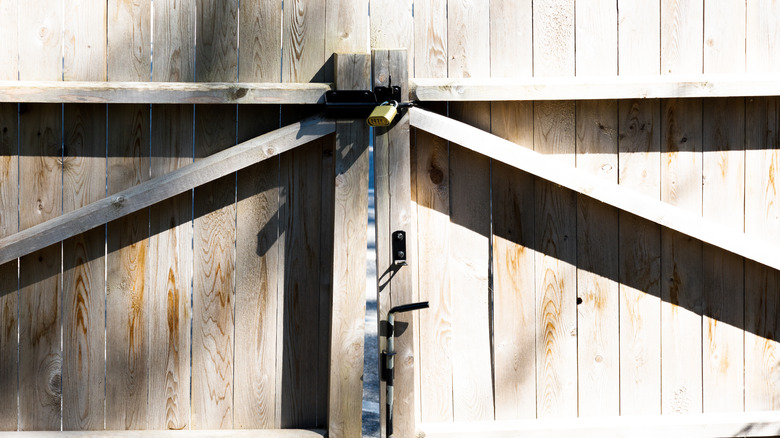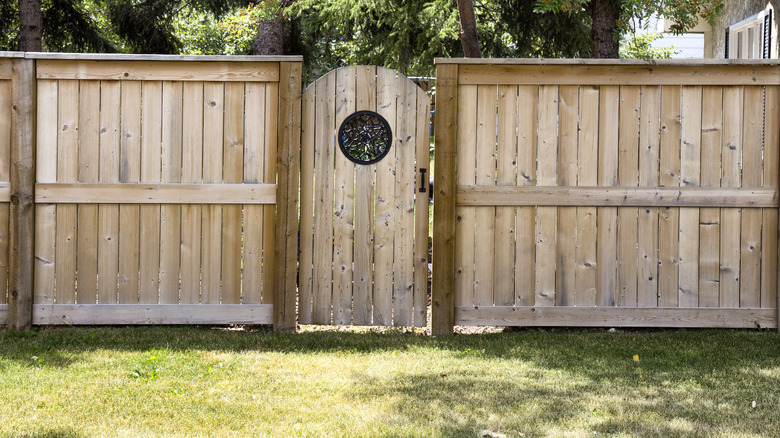Useful Tips For Fixing A Sagging Fence Gate That Won't Close
A fence gate that won't open isn't a gate, and one that won't close is neither a gate nor a fence. On top of being useless — or worse — a sagging gate can be so frustrating that you often end up just tromping through the house instead. And the icing on the, er, fence? They're usually an eyesore. The causes of such problems, aside from the bizarre possibility that you've iced your fence, are usually pretty straightforward. The solutions can be a bit more daunting. We spoke exclusively with House Digest's expert carpenter and remodeler, Bob Beacham, who has some guidance for anyone who's hanging onto a gate that's about to let go.
Beacham said there are three reasons for most gates sagging, and they're all pretty straightforward to deal with. A leaning fence post will obviously cause the attached gate to sag. If the hinges or the gate itself are in disrepair, that might also result in a slump. The root cause of the problem, though, is often found in the choices made when the fence was originally built. While there are many different types of fence materials you might consider, Beacham advocates for pressure-treated wood. "Pressure-treated lumber should be used," he told us. "This has been injected with chemicals to reduce rot and insect attack. It is widely available at timber merchants and DIY stores. It is very durable but won't last forever, so an annual coating with some kind of outdoor wood preservative is recommended."
If you're lucky, it's the gate or hinges causing a sagging fence
Naturally, you'll look to the simplest problems first: wonky hinges, or the gate itself. Hinges are probably the best-case scenario. "If they are old or rusted, they may have become loose and the gate will sag," Beacham told House Digest in an exclusive interview. "Replacing the hinges is quick, easy, and relatively inexpensive."
If you've used the right hinges from the outset, though, the problem is more likely to lie with the screws or nails attaching the hinges to the fence post, or with the condition of the wood those screws are driven into. It could also be a problem with excessive weight, like a gate that's too heavy or often has kids swinging on it, pulling the screws out. "If it's simply a case of the screws working loose, then tightening them may work and is the easiest solution," Beacham said. "If they aren't holding in the wood properly, you can try using larger screws. If that isn't possible or doesn't work, the holes can be drilled out, an appropriately-sized wooden dowel glued in, and the screws reset."
But when the wrong wood is used or an older gate or fence post has simply deteriorated over time, the solution can be more involved. "If the gate itself is sagging because it is old and the joints have loosened, it is possible to buy an anti-sag kit," Beacham said. "These use a steel bar to brace the gate diagonally. They may be functional but aren't necessarily a permanent fix, and not everyone likes the appearance. Sometimes replacing the gate is the only sensible option."
To fix a sagging fence, you'll often have to deal with the fencepost
There might be no way to avoid replacing the fencepost itself. This is more challenging than replacing the gate (if for no other reason than you also have to replace the gate when replacing the post). But it's best to avoid shortcuts that will inevitably put you back in the same situation in a few years, or even a few months. "One of the most common mistakes people make is trying to straighten a gatepost by hammering another piece of lumber in alongside and expecting it to stay upright," Beacham told House Digest when we spoke to him exclusively. "Sooner or later, it will lean over, too. The post needs to be removed and set properly. It's more work, but by far the best long-term solution."
"Set properly" means putting enough of the post below ground, and putting it in concrete. This makes the post more stable, and is a way to help keep your fence posts from rotting. "To provide adequate strength, ⅓ of the overall post height should be in the ground," Beacham said. "So for example, if 4 feet of the gatepost needs to be visible, there should be another 2 feet in the hole, giving a post that is 6 feet tall overall. Fence posts should be set in concrete so they stay fixed in position and vertical whatever the weather throws at them." The problem could also be that the wood is rotting or that the gate is, after all, too heavy, but Beacham says this isn't likely. "If it has been set properly, this won't generally be a problem," he said.


